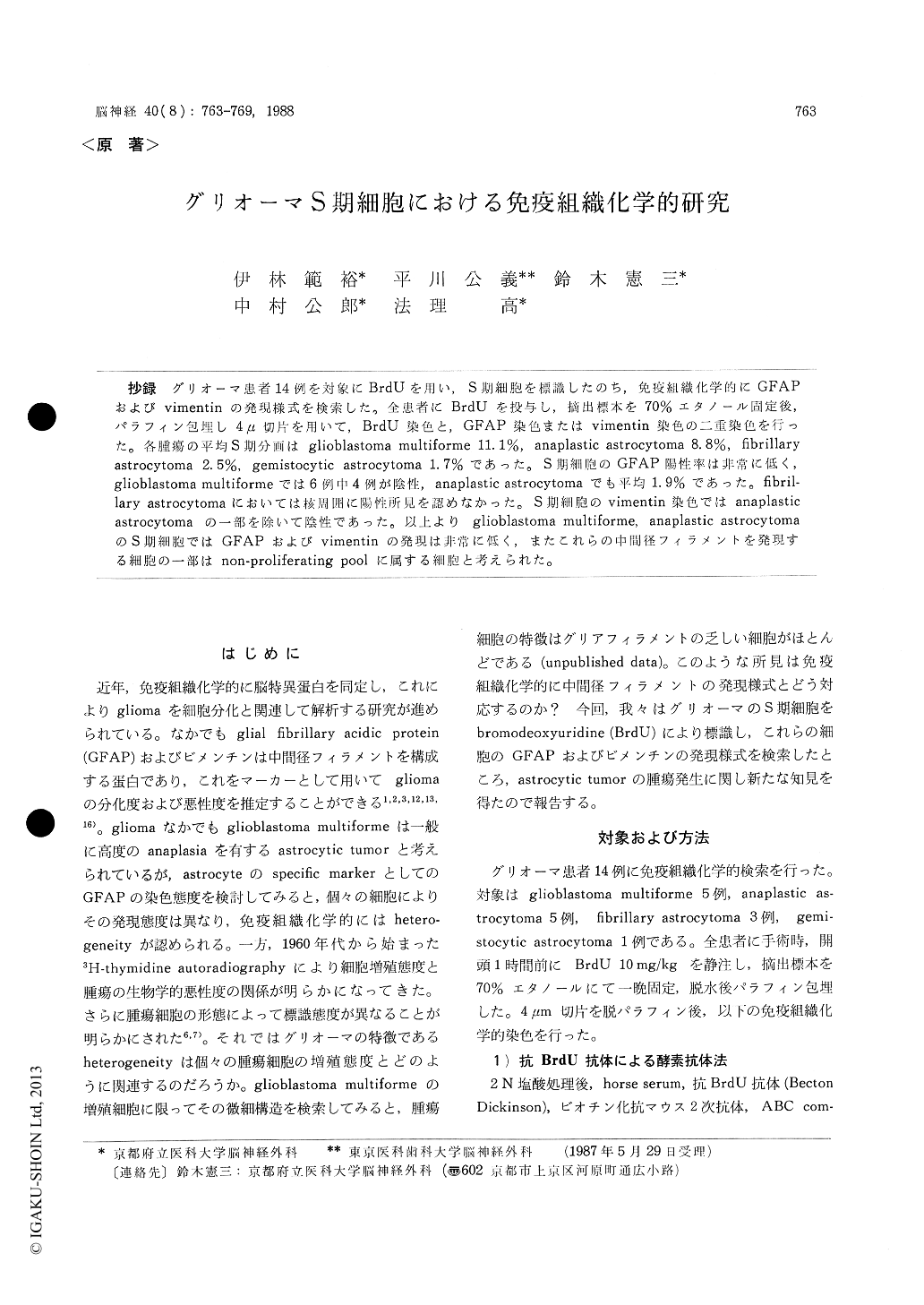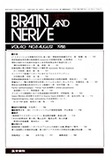Japanese
English
- 有料閲覧
- Abstract 文献概要
- 1ページ目 Look Inside
抄録 グリオーマ患者14例を対象にBrdUを用い,S期細胞を標識したのち,免疫組織化学的にGFAPおよびvimentinの発現様式を検索した。全患者にBrdUを投与し,摘出標本を70%エタノール固定後,パラフィン包埋し4μ切片を用いて,BrdU染色と,GFAP染色またはvimentin染色の二重染色を行った。各腫瘍の平均S期分画はglioblastoma multiforme 11.1%,anaplastic astrocytoma 8.8%,fibrillaryastrocytoma 2.5%, gemistocytic astrocytoma 1.7%であった。S期細胞のGFAP陽性率は非常に低く,glioblastoma multiformeでは6例中4例が陰性,anaplastic astrocytomaでも平均1.9%であった。fibril-lary astrocytomaにおいては核周囲に陽性所見を認めなかった。S期細胞のvimentin染色ではanaplasticastrocytomaの一部を除いて陰性であった。以上よりglioblastoma multiforme, anaplastic astrocytomaのS期細胞ではGFAPおよびvimentinの発現は非常に低く,またこれらの中間径フィラメントを発現する細胞の一部はnon-proliferating poolに属する細胞と考えられた。
Intermediate filament proteins are cytoskeletalcomponents in most vertebrate eukaryotic cells and some of these proteins are recognized markers of cell differentiation. To investigate the expres-sion of intermediate filament proteins of the S-phase cells in human glial tumors, we have ex-amined fourteen patients with benign and malig-nant gliomas by immunohistochemical study using in vivo labeling with bromodeoxyuridine (BrdU). Five glioblastoma multiformes, five anaplastic as-trocytomas, three fibrillary astrocytomas and one gemistocytic astrocytoma were studied. All patients were given intravenous infusion of BrdU (10 mg/kg) one hour before craniotomy for labeling the S-phase cells of the tumors. Surgical speci-mens were immersed in 70% ethanol, and embed-ded in paraffin. Four μm sections were immuno-stained with anti-BrdU monoclonal antibody (Mab) and anti-vimentin Mab by avidin-biotin complex (ABC) method, and anti-glial fibrillary acidic pro-tein (GFAP) serum by peroxidase-antiperoxidase (PAP) method. All sections (except for case 4) were double-labeled with anti-BrdU Mab and anti-GFAP serum, or with anti-BrdU Mab and anti-vimentin Mab. The population of BrdU-labeled cells (i. e. S-phase cells), and double-labeled cells were analyzed.
The proportions of BrdU-labeled cells ranged from 6.1% to 17.0% (average 11.1%) in glioblastoma multiformes, from 3.5% to 15.6% (average 8.8%) in anaplastic asrocytomas, and from 2.0% to 2.8% (average 2.5%) in fibrillary astrocytomas. One gemistocytic astrocytoma show-ed S-phase fraction of 1.7%. Two recurrent cases of anaplastic astrocytoma showed higher S-phase fractions than other non-recurrent cases of anaplastic astrocytoma. Although GFAP was found in various types of neoplastic astrocytes and in most reactive astrocytes in malignant astrocytic tumors, none of the S-phase cells were labeled with anti-GFAP antibody in three of the five glioblastoma multiformes, and less than 1. 0% of the S-phase cells were positive for GFAP in three of the five anaplastic astrocytomas. In the fibril-lary astrocytomas, in which diffuse fibirillary staining was seen, the S-phase cells showed no positive perikaryonal staining for GFAP. In one gemistocytic astrocytoma, only 5.3% of the cells in S-phase were labeled with with GFAP. Vi-mentin was found in most vascular endothelial cells and some fibroblasts in most cases of as-trocytic tumors. Although some neoplastic and reactive astrocytes in anaplastic astrocytomas and glioblastoma multiformes were labeled with anti-vimentin Mab, no tumor cells were positive for vimentin in fibrillary astrocytomas. In four glio-blastoma multiformes, three anaplastic astrocytomas,three fibrillary astrocytomas and one gemistocytic astrocytoma, none of the S-phase cells were po-sitive for vimentin. These findings showed that most of the S-phase cells in glioblastoma multi-formes and anaplastic astrocytomas had neither GFAP nor vimentin in their cytoplasm. It wassuggested that the cell which had GFAP or vi-mentin in their cytoplasm, might reside in the non-proliferating pool. The origin of these pro-liferating cells were discussed.

Copyright © 1988, Igaku-Shoin Ltd. All rights reserved.


